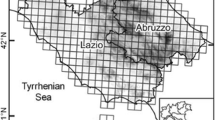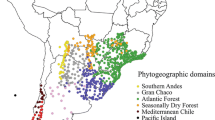Abstract
Species occurrences gathered from the literature, from atlases or from field surveys are currently used to analyze multispecific patterns, such as species richness or species geographic ranges. Such occurrences result from the independent recognitions of specimens by several botanists in particular places and at particular occasions. Thereby, the analysis of the resulting occasional ‘relevés’ involves the assignment of the species occurrences to spatial units such as a grid of quadrats. As a result, the distribution of occurrences among quadrats is controlled while their distribution among species is observed. In this paper we show how non-symmetric correspondence analysis (NSCA) enables the investigation of data structure by taking into account this fundamental asymmetry. We apply this new ordination technique to a list of endemic tree species occurrences in the Western Ghats (South India). We explore the interesting properties of NSCA as an ordination technique and demonstrate the usefulness of the method as a tool in biogeography. Regarding the Western Ghats, NSCA brings out the preponderance of deforestation over biogeographic history in explaining the observed multispecific patterns.
Similar content being viewed by others
References
Austin, M. P. 1985. Continuum concept, ordination methods and niche theory. Annu. Rev. Ecol. Syst. 16: 39–61.
Blackburn, T. M. & Gaston, K. J. 1996a. The distribution of bird species in the New World: patterns in species turnover. Oikos 77: 146–152.
Blackburn, T. M. & Gaston, K. J. 1996b. Spatial patterns in the species richness of birds in the New World. Ecography 19: 369- 376.
Bolognini, G. & Nimis, P. L. 1993. Phytogeography of Italian deciduous oak woods based on numerical classification of plant distribution ranges. J. Veg. Sci. 4: 847–860.
Brown, J. H., Stevens, G. C. & Kaufman, D. M. 1996. The geographic range: size, shape, boundaries, and internal structure. Annu. Rev. Ecol. Syst. 27: 597–623.
Crovello, T. J. 1981. Quantitative biogeography: an overview. Taxon 30: 563–575.
Currie, D. J. 1991. Energy and large-scale patterns of animal-and plant-species richness. Am. Nat. 137: 27–49.
De Franceschi, D. 1993. Phylogénie des Ebénales, analyse de l'ordre et origine biogéographique des espèces indiennes. Publication du Département d'Ecologie no 33, Institut Français de Pondichéry, Inde.
Dolédec, S., Chessel, D., Ter Braak, C. J. F. & Champely, S. 1996. Matching species traits to environmental variables: a new three-table ordination method. Env. Ecol. Stat. 3: 143–166.
Escoufier, Y. 1987. The duality diagram: a means of better practical applications. Pp. 139–156. In: Legendre, P. & Legendre, L. (eds), Development in numerical ecology. Springer-Verlag, Berlin.
Gaston, K. J. 1996. The multiple forms of the interspecific abundance-distribution relationship. Oikos 76: 211–220.
Gower, J. C. 1966. Some distances properties of latent root and vector methods used in multivariate analysis. Biometrika 53: 325–338.
Greenacre, M. J. 1984. Theory and applications of correspondence analysis. Academic Press, London.
Heikkinen, R. K. 1996. Predicting patterns of vascular plant species richness with composite variables: a meso-scale study in Finnish Lapland. Vegetatio 126: 151–165.
Hill, M. O. 1973. Reciprocal averaging: an eigenvector method of ordination. J. Ecol. 61: 237–249.
Hill, M. O. 1991. Patterns of species distribution in Britain elucidated by canonical correspondence analysis. J. Biogeogr. 18: 247–255.
Hill, M. O. & Gauch, H. G. Jr. 1980. Detrended Correspondence Analysis: an improved ordination technique. Vegetatio 42: 47- 58.
Hotelling, H. 1933. Analysis of a complex of statistical variables into principal components. J. Educ. Psychol. 24: 417–441.
Kruskal, J. B. 1964a. Multidimensional scaling by optimizing goodness of fit to a nonmetric hypothesis. Psychometrika 29: 1–27.
Kruskal, J. B. 1964b. Nonmetric multidimensional scaling: a numerical method. Psychometrika 29: 115–129.
Lande, R. 1996. Statistics and partitioning of species diversity, and similarity among multiple communities. Oikos 76: 5–13.
Lauro, N. & D'ambra, L. 1984. L'analyse non symétrique des correspondances. Pp 433–446. In: Diday, E. & Coll. (eds), Data Analysis and Informatics III. Elsevier, North Holland.
Legakis, A. & Kypriotakis, Z. 1994. A biogeographical analysis of the island of Crete, Greece. J. Biogeogr. 21: 441–445.
Light, R. J. & Margolin, B. H. 1971. An analysis of variance for categorical data. J. Am. Stat. Assoc. 66: 534–544.
Minchin, P. R. 1987. Simulation of multidimensional community patterns: towards a comprehensive model. Vegetatio 71: 145- 156.
Mourelle, C. & Ezcurra, E. 1996. Species richness of Argentine cacti: a test of biogeographic hypotheses. J. Veg. Sci. 7: 667–680.
Mourelle, C. & Ezcurra, E. 1997. Rapoport's rule: a comparative analysis between south and north american columnar cacti. Am. Nat. 150: 131–142.
Noy-Meir, I. & van der Maarel, E. 1987. Relations between community theory and community analysis in vegetation science: some historical perspectives. Vegetatio 69: 5–15.
Noy-Meir, I. & Whittaker, R. H. 1977. Continuous multivariate methods in community analysis: some problems and developments. Vegetatio 33: 79–98.
Oksanen, J. 1987. Problems of joint display of species and site scores in correspondence analysis. Vegetatio 72: 51–57.
Palmer, M. W. 1993. Putting things in even better order: the advantages of canonical correspondence analysis. Ecology 74: 2215–2230.
Pascal, J. P. 1984. Les forêts denses humides sempervirentes des Ghâts occidentaux de l'Inde: écologie, structure, floristique, succession. Travaux de la Section Scientifique et Technique 20, Institut Français de Pondichéry, Inde.
Pascal, J. P. 1988. Wet evergreen forests of the Western Ghats of India: ecology, structure, floristic composition and succession. Travaux de la Section Scientifique et Technique 20 bis, Institut Français de Pondichéry, Inde.
Peet, R. K., Knox, R. G., Case, J. S. & Allen, R. B. 1988. Putting things in order: the advantages of detrended correspondence analysis. Am. Nat. 131: 924–934.
Pitkänen, S. 1997. Correlation between stand structure and ground vegetation: an analytical approach. Plant Ecol. 131: 109–126.
Prendergast, J. R., Wood, S. N., Lawton, J. H. & Eversham, B. C. 1993. Correcting for variation in recording effort in analyses of diversity hotspots. Biodiv. Letters 1: 39–53.
Rahbek, C. 1997. The relationship among area, elevation, and regional species richness in neotropical birds. Am. Nat. 149: 875–902.
Ramesh, B. R. & Pascal, J. P. 1991. Distribution of endemic, arborescent evergreen species in the Western Ghats. Pp. 20–29. In: Proceedings of the Symposium on Rare, Endangered and Endemic Plants of theWestern Ghats. Kerala Forest Department.
Ramesh, B. R. & Pascal, J. P. 1997. Atlas of endemics of the Western Ghats (India). Distribution of tree species in the evergreen and semi-evergreen forests. Publication du Département d'Ecologie no 38, Institut Français de Pondichéry, Inde.
Rich, T. C. G. & Woodruff, E. R. 1992. Recording bias in botanical surveys. Watsonia 19: 73–95.
Schoener, T. W. 1987. The geographical distribution of rarity. Oecologia 74: 161–173.
Stevens, G. C. 1992. The elevational gradient in altitudinal range: an extension of Rapoport's latitudinal rule to altitude. Am. Nat. 140: 893–911.
Ter Braak, C. J. F. 1985. Correspondence analysis of incidence and abundance data: properties in terms of a unimodal response model. Biometrics 41: 859–873.
Ter Braak, C. J. F. 1986. Canonical Correspondence Analysis: a new eigenvector technique for multivariate direct gradient analysis. Ecology 67: 1167–1179.
Thioulouse, J. & Chessel, D. 1992. A method for reciprocal scaling of species tolerance and sample diversity. Ecology 73: 670–680.
Thioulouse, J., Chessel, D., Dolédec, S. & Olivier, J. M. 1997. ADE-4: a multivariate analysis and graphical display software. Statistics Computing 7: 75–83.
Wartenberg, D., Ferson, S. & Rohlf, F. J. 1987. Putting things in order: a critique of detrended correspondence analysis. Am. Nat. 129: 434–448.
Williams, P. H. 1996. Mapping variations in the strength and breadth of biogeographic transition zones using species turnover. Proc. R. Soc. Lond. B 263: 579–588.
Wright, D. H. 1991. Correlations between incidence and abundance are expected by chance. J. Biogeogr. 18: 463–466.
Rights and permissions
About this article
Cite this article
Gimaret-Carpentier, C., Chessel, D. & Pascal, JP. Non-symmetric correspondence analysis: an alternative for species occurrences data. Plant Ecology 138, 97–112 (1998). https://doi.org/10.1023/A:1009708824434
Issue Date:
DOI: https://doi.org/10.1023/A:1009708824434




